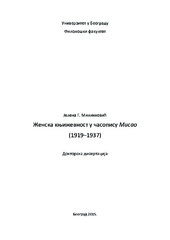Женска књижевност у часопису Мисао (1919-1937)
Womans literature in magazine Misao The Thought(1919-1937)
| dc.contributor.advisor | Dojčinović-Nešić, Biljana | |
| dc.contributor.other | Stokić Simončić, Gordana | |
| dc.contributor.other | Barać, Stanislava | |
| dc.creator | Milinković, Jelena G. | |
| dc.date.accessioned | 2016-07-30T15:26:17Z | |
| dc.date.available | 2016-07-30T15:26:17Z | |
| dc.date.available | 2020-07-03T12:16:27Z | |
| dc.date.issued | 2016-05-11 | |
| dc.identifier.uri | http://eteze.bg.ac.rs/application/showtheses?thesesId=3389 | |
| dc.identifier.uri | https://nardus.mpn.gov.rs/handle/123456789/6092 | |
| dc.identifier.uri | https://fedorabg.bg.ac.rs/fedora/get/o:11910/bdef:Content/download | |
| dc.identifier.uri | http://vbs.rs/scripts/cobiss?command=DISPLAY&base=70036&RID=48092431 | |
| dc.description.abstract | У овом раду се анализира женска књижевност у часопису Мисао (1919–1937). Под женском књижевношћу се подразумевају они текстови које су написале жене, тј. родна одређеност ауторства се узима као дистинктивна категорија. Анализа женске књижевности полази од постулата гинокритке о специфичној традицији литературе коју су писале жене. Традиција женске књижевности условљена је околностима у којима су жене стварале односно њиховим положајем у друштву. Уз то традиција женског стваралаштва је недовољно истражена и наизглед без континуитета. Уколико, како тврди Вирџинија Вулф, жене мисле кроз своје мајке, односно уколико је за свако књижевно дело битно оно што му претходи као референца у односу на коју ће се одређивати, онда је историја женске књижевности углавном историја лакуна, празних места, тачака прекида. У истраживању се полази и од закључака до којих се дошло на пројекту Књиженство, теорија и историја женске књижевности на српском језику до 1915. године, који финасира Министарство просвете, науке и технолошког развоја, а који се реализује на Филолошком факултету у Београду под руководстваом професорке Биљане Дојчиновић. Значајан сегмент овог пројекта представља база података у којој се налазе подаци о ауторкама које су свој први рад објавиле до 1915. године. База података показује нове моделе за предсављање историје књижевности и омогућава нови приступ у превазилажењу лакуна у историјском знању. Због тога се у разматрањима у овом раду која су дијахронијски усмерена указује на допринос базе података, али и дигиталне хуманистике уопште у савременим приступима проучавању књижевности... | sr |
| dc.description.abstract | In this paper we analyze women's writing in the magazine Misao The Thought (1919- 1937). By women's writing we consider texts written by women, i.e. gender determination of authorship is taken as a distinctive category. Analysis of women's writing is based on the postulate of gynocriticism, one about particular tradition of literature written by women. The tradition of women's writing is conditioned by the circumstances in which women created, regarding their position in society. Further, a tradition of women's creativity is insufficiently researched and seemingly without continuity. If, as claimed by Virginia Woolf, women think through their mothers, and if it is essential for any work of literature what precedes it as a reference in respect of which it will be determined, then the history of women's writing is mainly history of lacunas, vacancies and breakpoints. The research is also based and the conclusions that have been reached within the project Knjiženstvo, Theory and History of Women's Writing in the Serbian until 1915, funded by the Ministry of Education, Science and Technological Development, which was implemented at the Faculty of Philology in Belgrade. A significant segment of this project is a database containing information about the authors who have published their first work before 1915. This database shows new models for the presentation of the history of literature and provides a new approach in overcomeing lacunas in historical knowledge. Therefore, the considerations in this paper are diachronically focused to indicate the contribution of the database, but also the contribution of humanities in general to contemporary approaches of the studies of literature... | en |
| dc.format | application/pdf | |
| dc.language | sr | |
| dc.publisher | Универзитет у Београду, Филолошки факултет | sr |
| dc.rights | openAccess | en |
| dc.rights.uri | https://creativecommons.org/licenses/by-nc-nd/4.0/ | |
| dc.source | Универзитет у Београду | sr |
| dc.subject | женска књижевност | sr |
| dc.subject | women’s writing | en |
| dc.subject | часопис Мисао | sr |
| dc.subject | међуратна периодика | sr |
| dc.subject | међуратна књижевност | sr |
| dc.subject | феминофилне уредничке политике | sr |
| dc.subject | књиженство | sr |
| dc.subject | magazine Misao The Tought interwar periodicals | en |
| dc.subject | interwar literature | en |
| dc.subject | feminofilistic magazines | en |
| dc.subject | knjizenstvo | en |
| dc.title | Женска књижевност у часопису Мисао (1919-1937) | sr |
| dc.title | Womans literature in magazine Misao The Thought(1919-1937) | en |
| dc.type | doctoralThesis | en |
| dc.rights.license | BY-NC-ND | |
| dcterms.abstract | Дојчиновић-Нешић, Биљана; Бараћ, Станислава; Стокић Симончић, Гордана; Милинковић, Јелена Г.; Ženska književnost u časopisu Misao (1919-1937); | |
| dc.identifier.fulltext | http://nardus.mpn.gov.rs/bitstream/id/31992/Milinkovic_Jelena_G.pdf | |
| dc.identifier.fulltext | http://nardus.mpn.gov.rs/bitstream/id/31991/Disertacija4019.pdf | |
| dc.identifier.fulltext | https://nardus.mpn.gov.rs/bitstream/id/31992/Milinkovic_Jelena_G.pdf | |
| dc.identifier.fulltext | https://nardus.mpn.gov.rs/bitstream/id/31991/Disertacija4019.pdf | |
| dc.identifier.rcub | https://hdl.handle.net/21.15107/rcub_nardus_6092 |



